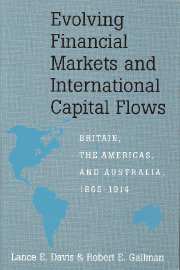 Evolving Financial Markets and International Capital Flows
Evolving Financial Markets and International Capital Flows Published online by Cambridge University Press: 18 August 2009
Introduction
It was not that British savers were born with a lesser degree of aversion to uncertainty than their counterparts in the four frontier countries, it was simply that Britain had begun to develop earlier, and by the middle of the nineteenth century the process of educating savers had proceeded much further than it had in the outlands. Although a double-digit savings rate was not achieved until the early decades of that century, capital had been accumulating in trade and commerce for at least 300 years. It may well have been true, as Postan has noted, that at least two fifteenth-century families could have provided all the finance required to fund the entire Industrial Revolution. However, those (and other elite) families chose not to redirect their existing portfolios, to meet either the relatively small demands of the manufacturing sector – demands that were met largely out of retained earnings – or, much more importantly, the demands for supporting investment in infrastructure, particularly canal construction.
Although her findings have been subject to criticism, Elise S. Brezis has concluded that from 1740 to the end of the century the national savings rate, although rising, rose by substantially less than the investment rate. As a result, for the century as a whole, given the level of military expenditures, domestic savings were insufficient to finance the observed level of investment, and there was a need for foreign capital imports.
To save this book to your Kindle, first ensure [email protected] is added to your Approved Personal Document E-mail List under your Personal Document Settings on the Manage Your Content and Devices page of your Amazon account. Then enter the ‘name’ part of your Kindle email address below. Find out more about saving to your Kindle.
Note you can select to save to either the @free.kindle.com or @kindle.com variations. ‘@free.kindle.com’ emails are free but can only be saved to your device when it is connected to wi-fi. ‘@kindle.com’ emails can be delivered even when you are not connected to wi-fi, but note that service fees apply.
Find out more about the Kindle Personal Document Service.
To save content items to your account, please confirm that you agree to abide by our usage policies. If this is the first time you use this feature, you will be asked to authorise Cambridge Core to connect with your account. Find out more about saving content to Dropbox.
To save content items to your account, please confirm that you agree to abide by our usage policies. If this is the first time you use this feature, you will be asked to authorise Cambridge Core to connect with your account. Find out more about saving content to Google Drive.